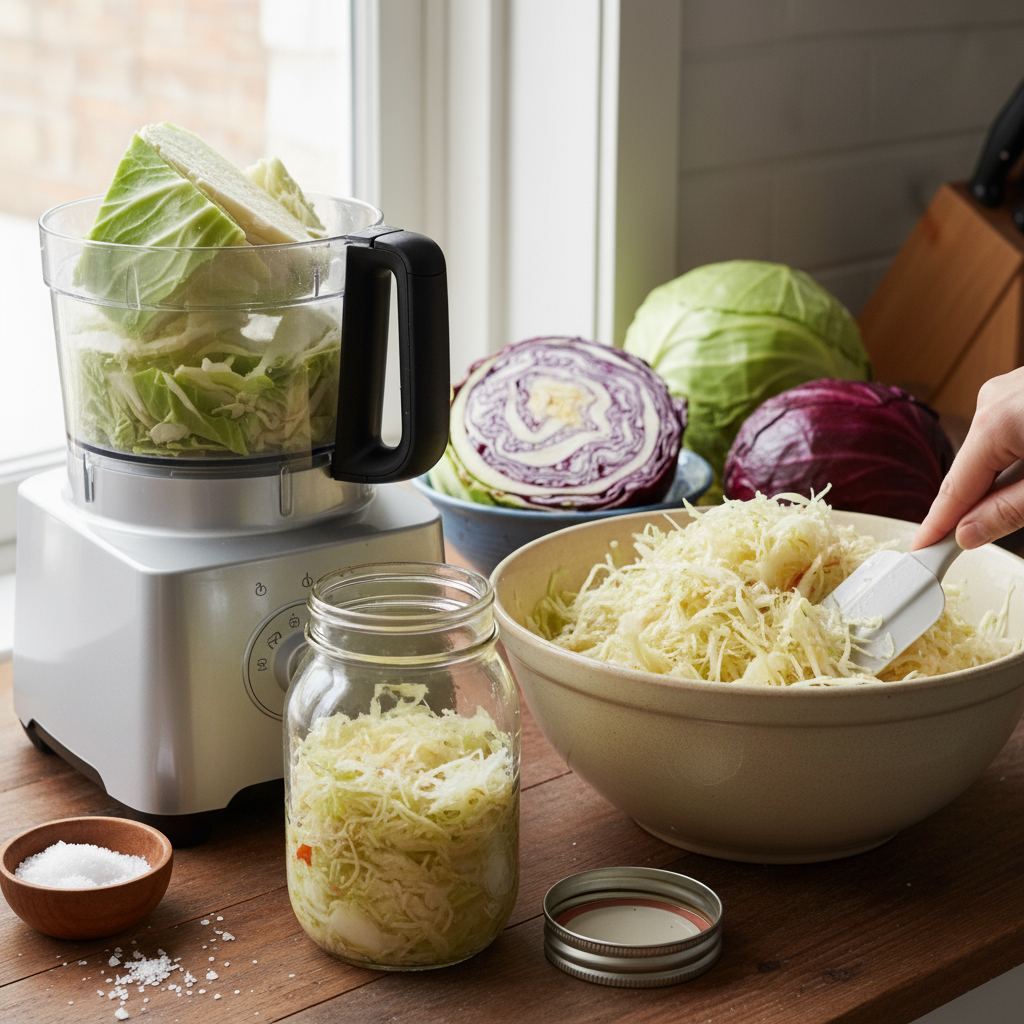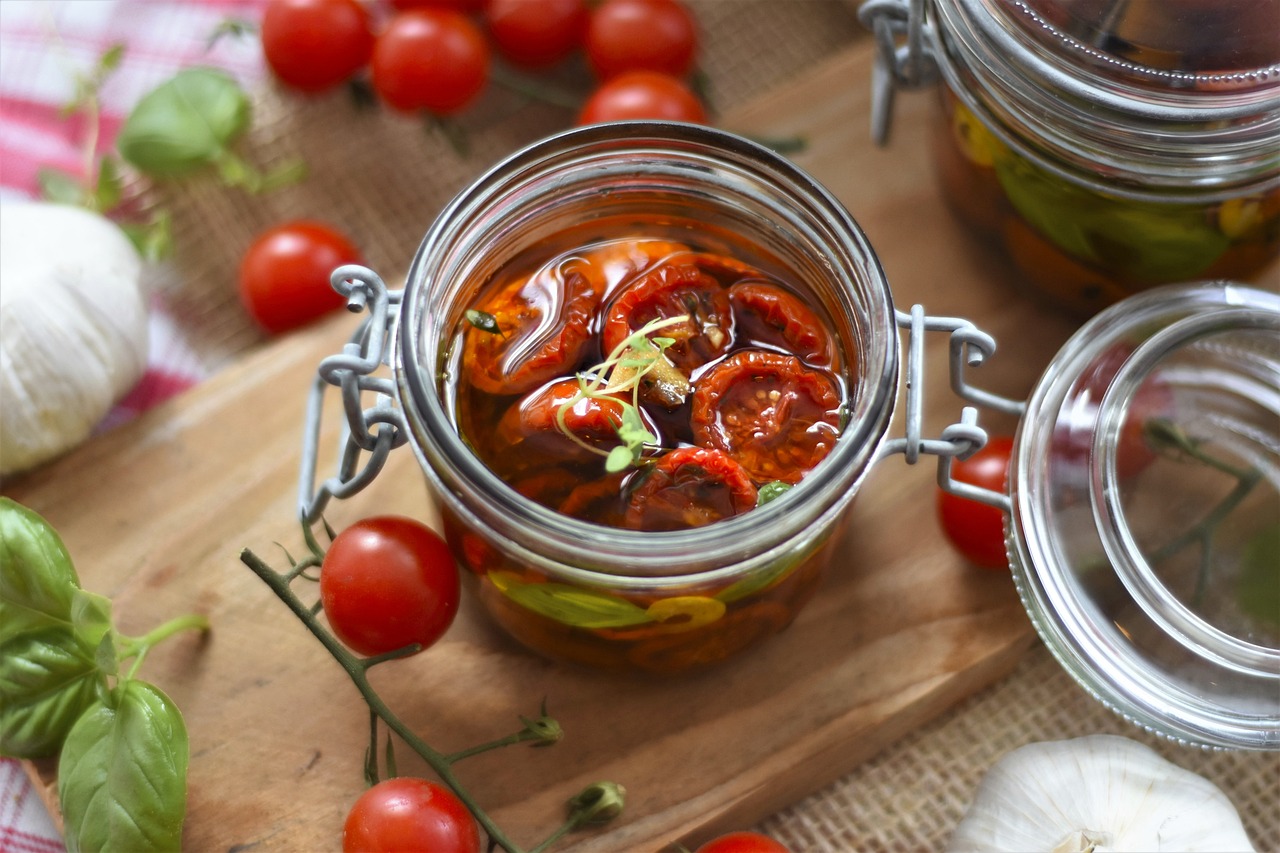Sauerkraut: A Simple Recipe for Homemade Goodness

You can make delicious old-fashioned sauerkraut using nothing but organic cabbage and sea salt. I find a simple dish consisting of two ingredients to be very refreshing in a world filled with foods that have long ingredient lists populated with unknown items that were dreamed up in a science lab.
This old-fashioned dish gets its unique flavor from a fermentation process. The way my grandmother taught me to make sauerkraut was time-consuming and required a bit of muscle. We would shred the cabbage by hand with a kitchen knife then pound it with a rubber mallet for 15 to 20 minutes. This process released the natural cabbage juice that keeps the cabbage moist and prevents it from rotting during the fermentation process. I still use my grandmother’s simple and basic old-fashioned sauerkraut recipe, but I get help from a very modern kitchen appliance: the food processor. The food processor not only shreds the cabbage, but swapping out the shredding disc for a multi-purpose blade allows me to “bruise” the cabbage without a mallet. This way is a lot easier.
Old Fashioned Sauerkraut
Ingredients for One Quart of Sauerkraut:
- 1 medium to large organic cabbage (green or red is fine)
- 2 tablespoons of sea salt
Special equipment
- A food processor with both a shredding disc and multi-purpose blade
- A one quart wide mouth glass canning jar
Directions:
Cut the organic cabbage into quarters and remove the core. Place the shredding disc on your food processor. Shred the cabbage. Put the shredded cabbage into a mixing bowl along with the sea salt. Stir until the salt is very well-distributed. Let the salted cabbage sit for fifteen minutes to allow the sea salt to begin to draw out the natural cabbage juices. Return the salted cabbage to the food processor work bowl, but this time have it fitted with a multi-purpose blade. You may have to process the cabbage in batches if your food processor isn’t large enough to handle the entire cabbage all at once. Press the pulse button on your food processor 8 times, only holding it down for 2 seconds each time. This will break down the cabbage enough to get out the juices you need, but still leave it in large enough pieces for the final sauerkraut to have a good texture.
Place the processed sauerkraut into the glass canning jar. Press down the cabbage until the juices rise 3/4 of an inch above the cabbage. A rubber spatula works well for this task. Put the lid tightly on and place the sauerkraut in a cool (but not cold) dark place for 5 days. A dark cupboard is a good spot for this. Move the sauerkraut to the refrigerator at the end of the 5 days. Refrigerate the sauerkraut for at least one week before serving. The flavor will continue to improve with age, and it will hit its peak at 4 to 6 months.
In Germany, cooked sauerkraut is often flavored with juniper berries or caraway seeds; apples and white wine are added in popular variations. | source
Tips and Suggestions
I have had friends request this recipe but tell me it did not work for them. All they ended up with was soggy, salty cabbage. It took me a while to figure why it wouldn’t work for other people even though this method always works for me. I finally realized that I usually only use organic foods, while other people buy cheaper, conventionally grown vegetables. Those vegetables are heavily sprayed with pesticides, which indiscriminately kill all living microbes, both good and bad. Fermentation works by encouraging the growth of healthy bacteria (probiotics) naturally present on foods, cabbage in this case. These cabbage probiotics are able to withstand high levels of salt, unlike most microbes. So the salt gets rid of competing bacteria, allowing the good cabbage bacteria to flourish. That is how sauerkraut is made. This process does not work with heavily sprayed cabbage, so it is very important to only use organic cabbage when making this recipe.
You will want to use a well-powered food processor with a sharp blade for this sauerkraut recipe, otherwise you will end up with mushy cabbage.
>> How to Prepare a Reuben Sandwich
The Author:
Heather Krasovec loves all things related to food! I have worked in the retail food industry, the restaurant industry and as a personal chef. I am now focused on food as it relates to health. I believe food should be prepared at home from scratch whenever possible. No one can achieve good health on a diet of mass-produced pre-packaged, processed foods. It is my goal to teach people how to eat well and to prepare food for maximum nutrition with minimal effort.
Photo. Gemini
Source: EA









CAN I use a blender or grinder instead of food processor because I do not have a food processor
While you can certainly try using a blender or grinder as a substitute for a food processor to make sauerkraut, it may not yield the same results. The texture of the sauerkraut might not be as desired and it could potentially turn out too watery or soggy. It is worth noting that a food processor is specifically designed for tasks like shredding cabbage, so it might be the ideal tool for this recipe. However, if you don’t have a food processor, you can still try using a blender or grinder, but be prepared for slightly different results. It may be a good idea to give the cabbage a few pulses or grind it in small batches to achieve a more desirable texture.
thank you so much for this information! as an old lady, it’s harder to pound for so long, and I was wondering if it was okay to use the processor for my organic cabbage
You’re very welcome! Using a food processor can definitely be a convenient option, especially if pounding becomes more difficult. Feel free to give it a try with your organic cabbage and see how it turns out. It’s always great to find ways to make things easier in the kitchen, especially as we get older. Enjoy your homemade sauerkraut!